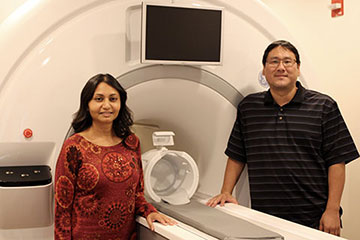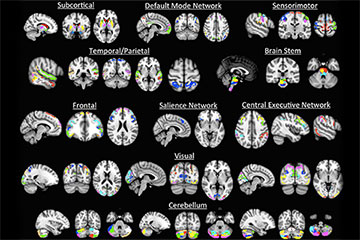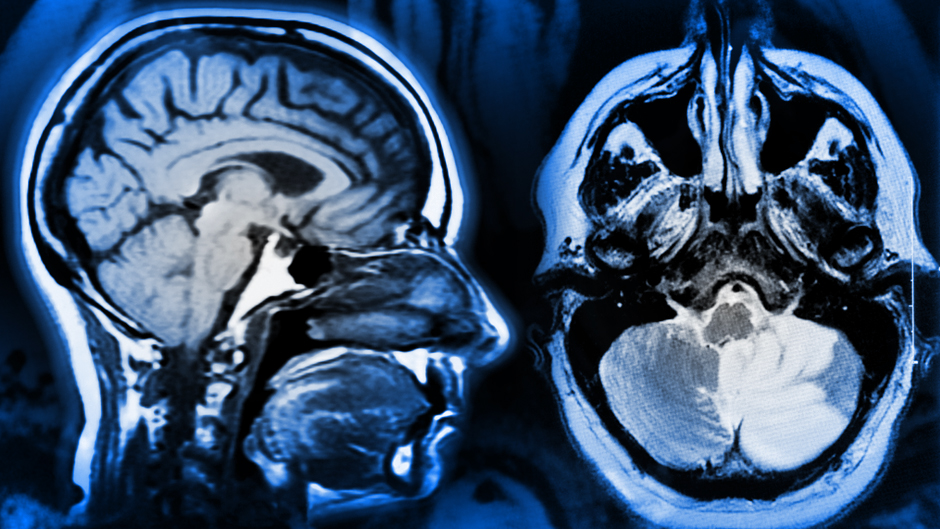Your brain is never really at rest. Neither is it in chaos. Even when not engaged in some task, the brain naturally cycles through identifiable patterns of neural connections—sort of like always practicing your favorite songs when learning to play the guitar.
Constantly cycling through brain region connections may make it easier to call to those networks when you need them for high-level cognitive processing, such as memory and attention. The network connections are not all equal, either. Some are more flexible and adaptable than others.
 |
| Lucina Uddin, assistant professor of psychology and principal investigator in the Brain Connectivity and Cognition Laboratory (BCCL), and Jason Nomi, postdoctoral fellow in the Department of Psychology and the BCCL, stand next to the Lab’s fMRI scanner. |
This is what Lucina Uddin and Jason Nomi, cognitive neuroscientists at the University of Miami College of Arts and Sciences, found when collaborating with researchers at the University of New Mexico on a study that researchers hope will lay the groundwork for helping children with autism adapt to change more easily. The scientists analyzed an extensive data set of brain region connectivity from the NIH-funded Human Connectome Project (HCP), which is mapping neural connections in the brain and makes its data publically available.
To better understand the human brain connectome, the HCP collected data from hundreds of people who underwent 56 minutes of resting-state functional magnetic resonance imaging (fMRI). A revolutionary tool in brain-mapping research, fMRIs measure brain activity by detecting changes in cerebral blood flow that are associated with brain activity and neural activation. The HCP also collected a number of other measurements, including the subjects’ ages, IQs, and results on various mental tasks.
Nomi, Uddin, and their fellow researchers analyzed the HCP’s resting-state fMRI data and, from potentially hundreds of configurations, teased apart five general brain patterns. They discovered that, most of the time, neural connections in the typical adult population are agile—alert yet fluid and flexible enough to take on whatever challenges or mental tasks are presented.
Less frequently, the brain cycles through more rigid connections where the regions are linked in a very specific, less flexible way, says Uddin, assistant professor of psychology and principal investigator in the Brain Connectivity and Cognition Laboratory (BCCL).
The researchers then correlated the frequency of these five brain patterns with performance on executive-function tasks—completed outside of the fMRI brain scanner—that tap high-level cognition, such as sorting a deck of cards by the printed image’s color and then by its shape. What they found was higher performers tend to have a natural propensity to be in the more flexible and fluid brain states.
 |
| The 100 individual brain areas that were used to determine different network configurations during the resting-state fMRI scan. |
“People who do better on these tasks tend to have more of the relaxed, flexible brain configuration states and less of the more rigid configuration states,” says Nomi, a postdoctoral fellow in the Department of Psychology and the BCCL.
With this better understanding of brain activity in a typical population, the researchers are now moving to the next step of their research: testing children with autism to see whether their brains have a natural propensity to spend more time in the more rigid network configurations, making it harder for them to adapt to change as they experience life.
“The final step is determining what can we do to help them do better,” Uddin says. “Is there a way to induce a brain state that helps children with autism more flexibly adapt? Are there training programs or behavioral therapies that help them become more flexible? And if there are, do they also help their brains become more flexible?”
Uddin, Nomi, and their fellow researchers who study the connection between neuroscience and behavior are excited about the direction neuroimaging has taken their field.
“In the field of neuroimaging, before, we would have a snapshot of the brain. Now, we have a movie,” says Uddin.
Neuroscientists are also making more data publically available, and building interdisciplinary collaborations to analyze big data. Uddin, Nomi, and their collaborators were able to analyze more than 80 gigabytes of data for the connectome study in weeks, rather than months, by using the supercomputing resources at UM’s Center for Computational Science (CCS).
For the follow up study on children with autism, Uddin and Nomi have been working closely with UM’s Michael Alessandri, clinical professor of psychology and executive director of the University of Miami-Nova Southeastern University Center for Autism and Related Disabilities (UM-NSU CARD); Melissa Hale, clinical assistant professor of psychology and UM-NSU-CARD’s associate director; and Meaghan Parlade, a licensed psychologist at the Autism Spectrum Assessment Clinic (ASAC) in the Department of Psychology as well as the coordinator of research and training for UM-NSU CARD.
The team’s UMiami Brain Development Lab is looking for children ages 7 to 12, who are typically developing or who have autism, to help them understand more about how the brain functions in both populations. Parents can learn more by viewing this video.
For their research study, “Chronnectomic Patterns and Neural Flexibility Underlie Executive Function,” Nomi and Uddin worked with Shruti Gopal Vij, a biomedical engineer and postdoctoral researcher in the Brain Connectivity and Cognition Lab and The Mind Research Network in Albuquerque; Dina Dajani, a graduate student in psychology at UM’s College of Arts and Sciences; Rosa Steimke, a visiting postdoctoral researcher in psychology in the Brain Connectivity and Cognition Lab; Eswar Damaraju and Srinivas Rachakonda, of The Mind Research Network; and Vince Calhoun, of The Mind Research Network and the Department of Electrical and Computer Engineering at the University of New Mexico.
Their study is published online in NeuroImage.

